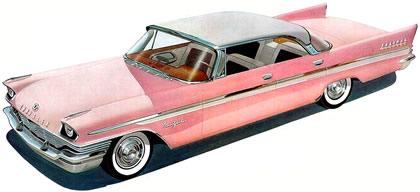Although they never used this particular pitch, they could have said about the 1957 Chrysler New Yorker “fins that reach the sky.” For whatever reason, Chrysler was the automaker that popularized the fin. Really after the retirement of the Chrysler fin by 1960, the only place you could see a fin like that was in the movie “Jaws.”
 To be truthful, though, when you look at the lines of the 1957 New Yorker as a whole, the fins work. The ad that was used was that Chrysler’s design had established a new “Forward Look.” Now, if that meant a lowered body line and reed-like roofline and lots and lots of glass in the greenhouse, plus rear quarters that finished in huge upright fins, then they hit the mark and then some. Still with this design, the fins work well.
To be truthful, though, when you look at the lines of the 1957 New Yorker as a whole, the fins work. The ad that was used was that Chrysler’s design had established a new “Forward Look.” Now, if that meant a lowered body line and reed-like roofline and lots and lots of glass in the greenhouse, plus rear quarters that finished in huge upright fins, then they hit the mark and then some. Still with this design, the fins work well.
For 1957, the year before a two-year recession gripped the industry, the $4,600 that Chrysler charged for the New Yorker was a lot of money, but you had to admit that for those who laid it out, the New Yorker looked great.
The lower valence was actually the chromed bumper and the hood sloped down and around the grille and worked nicely with the dual quad headlights that this style helped to popularize. The dual quads were fared into the front fenders and the fender line was carried all the way back through the rear quarters. An interesting design feature was a small chrome counter strip that ran the length the body, essentially establishing a dual beltline. The rockers were chromed.
The 1957 New Yorker established a new ride and handling standard, the torsion bar front suspension. Rather than rely on the recirculating ball and control-arm front suspension common to the period, Chrysler used a specialized torsion arm that on helped to stiffen the frame as it against body stress to keep the wheels on the ground. Typical suspensions of the day bounced and the recirculating ball tended to allow lots of wheel jounce and bounce and the handling left a lot to be desired, while the torsion bar smoothed out the bounces and not only helped handling but also the ride quality.
The New Yorker also added a three-speed Torque Flite automatic. This was at the time when Detroit liked to use those funky pushbuttons to not only start the car but also put into gear. Typically, the button pod was located on the upper left.
Hemi-powered the New Yorker line was offered with V-8s that ran from 354 to 392 cubic inches put out up to 325 horsepower.
The New Yorker was available in two-door hardtop and convertible versions and features a nicely styled interior. For the driver, the instruments were contained within a single pod dominated by a large speedometer.
